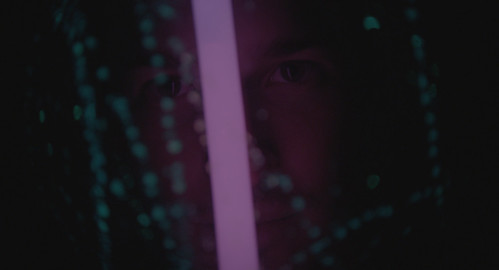On Set
Shooting The Happiness Machine with Glow Sticks and ALEXA
On 21, Aug 2013 | No Comments | In On Set | By Colton Davie
A couple of months ago, I shot the music video for “Peace Hands” by The Happiness Machine, an indie garage rock band from St. Petersburg, FL. Director Bryce McGuire had memories of the cathartic, slightly rebellious act of cutting open glow sticks and splashing them around a dark room, creating colorful galaxies only to disappear as soon as the lights turned on, and built a simple narrative around that experience.
We shot with the ALEXA and a set of Ultra Primes, but otherwise the one day shoot was no budget, super guerrilla style. The exterior/pre/post-glow stuff was pretty simple. We shot it late in the afternoon after doing all the glow stick shots. We used all natural light, except for a silver 4×4” bounce punching some sunlight deeper into the garage.

A frame grab from the test footage.
The bulk of the day, however, was of course spent in the “glow room”. Prior to the shoot, Bryce and I had shot some tests to see if the glow juice was even bright enough to show up on camera. We shot the test in a bathroom, where it would be easy to clean up, and we were excited to find that the juice was plenty bright.
Because we knew things were going to get messy, we decided to shoot more-or-less in chronological order. To carry the audience into the glow room, Bryce wanted to start with slow motion shots of the glow sticks coming to life. Aside from the glow sticks, there was no other light in the room. We were exposing the Alexa at its native 800ISO and were already wide open on the Ultra Primes at T1.9 at 24fps, so going to 48fps meant losing another stop from an already low exposure. We immediately found that the green glow sticks were far brighter than the purple ones, hence Kathleen holding 2 purple glow sticks for most of the video, as opposed to Shaundra’s 1 green. As long as Shaundra held the glow stick relatively close, the green ones were bright enough to give a healthy exposure even at 48fps, so most of the slow-motion stuff focuses on her. One of the things we liked about using the glow sticks as a source was that the direction of the light could freely move, creating dynamic shadows and looks within the shot, so our goal was to keep the glow sticks always in motion.
For the performance shots, such as when Kathleen uses the glow juice as face paint, Bryce did not want to see the glow sticks themselves, just the light from them. So Bryce would move a couple of purple sticks around just out of frame while Kathleen did her thing. To create the green backlight on her hair, I put my iPhone in a stand behind her and using Prismatic, an app that allows you to fill your screen with any solid color, I tried to match the green glow stick as much as I could, and used the iPhone screen as the backlight. For other performance shots, we had Kathleen stand behind a clear shower door, holding two glow sticks to light herself, while Bryce splashed the wall behind her and the shower door in front of her throughout the take, creating multiple layers of interest.

Preparing for the glow juice fight.
Most of the splashing and moving around the room stuff was shot very freeform. With the camera on my shoulder, I would dance around the room with the girls, following their actions and occasionally giving directions. For some shots, to get extra light on the girls’ faces, we rigged a glow stick boom, using a c-stand arm with a couple of glow sticks clamped on, sometimes with foil along one side as a reflector, and Bryce or 1st AC Leo would fly the glow sticks or an iPhone with either green or purple screen around to boost the lighting. While the iPhone was nice to have, I found that I liked the quality of light from the actual glow sticks better, as it was a little softer and the color more “natural.”
For most of the glow room, we were on the ragged edge of exposure. Even at 24fps, the waveform was usually pretty bottomed out, and sometimes it was even hard for me to see what I was shooting through the viewfinder. But we were committed to the concept, and to add anymore light would have quickly and dramatically changed the look of the picture.
We recorded 1080p LogC to ProRes4444. I created ProRes422 dailies with a one-light look applied using FCP. For the online, I went back to the original LogC footage and graded in Apple Color. Much of the information was pretty deep in the shadows, but the LogC encoding retained the information very well. For the exterior/garage stuff, I graded under Arri’s LogC to Rec709 LUT, but the LUT did some weird things with the saturation of the glow sticks, so for the glow room I graded without any LUT. I’m very happy with the fact that the camera left plenty of headroom for the glow sticks, so that even when I brought up the light on the faces, the sticks were able to retain color and not clip.
Regarding the glow sticks, a lawyer would probably say, “don’t try this at home.” Care should be taken to ensure plenty of fresh air, and that the juice does not get in anyone’s eyes. We also had a clear filter in the mattebox the whole time to protect the lenses.
Check out the finished video below:
Enjoy!
Colton Davie, Cinematographer


Submit a Comment